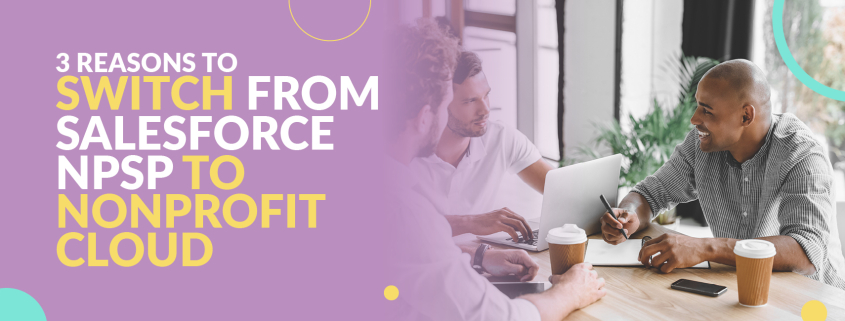3 Reasons to Switch from Salesforce NPSP to Nonprofit Cloud
Salesforce is one of the top CRM providers for businesses, associations, and nonprofits. As a nonprofit professional, you may be familiar with Salesforce’s nonprofit solution Nonprofit Success Pack (NPSP), built on top of its core CRM as a comprehensive, user-friendly fundraising tool and CRM.
Thousands of organizations have found success with NPSP over the years, so much so that Salesforce decided to transition its nonprofit-specific technology to a more robust offering in Nonprofit Cloud. Nonprofit Cloud boasts more features, a new data model, and a stable infrastructure within Salesforce. However, Salesforce plans to continue supporting NPSP, leaving nonprofits to question if switching to Nonprofit Cloud is right for their organization.
In this guide, we’ll explore the basics of Nonprofit Cloud and why it might be best for your organization to implement this new tool. Let’s start by covering what Nonprofit Cloud is and what it means for nonprofits using NPSP.
What is Salesforce Nonprofit Cloud?
As Fíonta’s guide to the Salesforce nonprofit family explains, Salesforce Nonprofit Cloud is an expansion of the existing package of nonprofit technology. Nonprofit Cloud is meant to be a one-stop-shop for nonprofit organizations, offering technology to assist with case and program management. Fundraising features will be added as soon as Winter 2023.
Why Use or Switch to Nonprofit Cloud?
1. It is a core product on the Salesforce platform.
NPSP is essentially a set of apps installed on the Salesforce platform, often called a managed package. While nonprofits using NPSP were able to take advantage of new releases from Salesforce, managed packages are not considered core products and have more difficulty smoothly connecting with other Salesforce tools.
Salesforce’s core products are considered foundational to the platform, whereas managed packages function as extensions of the core product, often developed by a third party or Salesforce partner. While both can be effective tools for nonprofits, here are some considerations to keep in mind about core products like Nonprofit Cloud:
- It will receive investments from Salesforce. As a core product, Salesforce will invest more heavily in Nonprofit Cloud in the future. Nonprofits using Nonprofit Cloud can count on continued updates and use it alongside other Salesforce offerings outside of the NPSP data model.
- It is one of the Salesforce Industry Clouds. Salesforce offers collections of cloud-based tools designed specifically for different industries, such as the Financial Services Cloud. Nonprofits in industries that require precise reporting and compliance features, like healthcare organizations, can easily connect with data stored in Nonprofit Cloud to other relevant Industry Clouds.
- It is built on the Industry Data Model. The Industry Data Model is the model used by all of the Salesforce Industry Cloud Solutions. This means that going forward, Nonprofit Cloud users can seamlessly access and implement tools from other industry clouds. For example, your nonprofit might leverage tools from the Financial Services cloud for tasks like donor management, data analytics, wealth screening, and financial tracking.
Overall, this means that it will be possible for nonprofits to use more of Salesforce’s offerings. However, migrating to the new data model can be time- and labor-intensive. For advice on how to navigate this change and prepare your data for the transition, consider working with an industry expert such as a Salesforce partner.
2. It offers access to more tools.
Because of its Industry Cloud status, Nonprofit Cloud can provide your nonprofit with more tools through the Common Features available for use in multiple Industry Clouds.
Some new offerings your nonprofit could take advantage of with Nonprofit Cloud include:
- OmniStudio. Using OmniStudio, your nonprofit can develop positive, guided user experiences. For example, you might use this feature to guide supporters through your organization’s volunteer onboarding process, improving your stewardship efforts. OmniStudio does not rely on custom code but instead offers drag-and-drop configuration capabilities so you can set up these guided experiences in just a few clicks. For NPSP users, this is somewhat similar to Flow or Apex.
- Actionable Relationship Center (ARC). This tool is similar to the NPSP’s Relationship Viewer, but it offers a more comprehensive and easy-to-visualize way to view donor relationships. If your nonprofit uses Experience Cloud, you can further customize it with ARC. For example, you might allow partner organizations to view ARC relationship graphs to understand how they’re connecting with your supporters.
- Identity Verification. This feature offers an easy way for your nonprofit to validate an individual’s identity before allowing them to access certain pages of your website or disclosing sensitive information. This is important for staff members, volunteers, and program participants who may access or be told sensitive data.
Remember that no matter which of these features your nonprofit may need to use, they will integrate seamlessly with the other features included in Nonprofit Cloud.
3. It supports long-term scalability.
Nonprofit Cloud is designed to accommodate your nonprofit’s growing and changing needs, helping you better manage projects, oversee staff and operations, and obtain sustainable funding.
Additionally, its data analysis and reporting tools, like Einstein Analytics, are built to support growing organizations with large volumes of data. For example, when creating your annual report, you follow best practices such as those outlined in Double the Donation’s guide to annual reports that advise you to use concrete data and statistics. Because you use Nonprofit Cloud, you quickly and easily organize your data and generate custom reports that reveal the exact statistics needed for the report.
To weigh the pros and cons of switching to Nonprofit Cloud, consider working with a managed services partner who can provide their expertise, assist you in implementing new technology, and optimize the solutions and apps in your toolkit.




